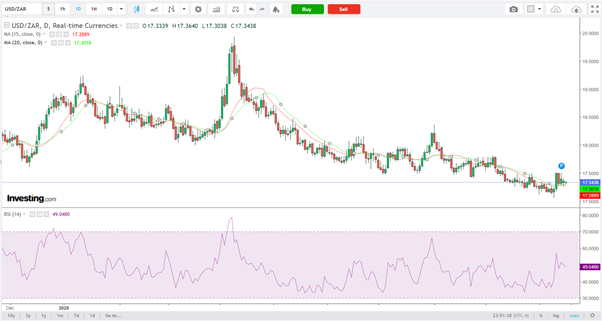Two National Guard members shot near White House
The USD/ZAR pair closed at 17.34, with an intraday high of 17.36 and a low of 17.30. It continues to consolidate after rebounding from multi-month lows near 17.00, as improving global risk sentiment offsets the broad US dollar strength. Momentum remains neutral, with the rand showing resilience despite a stronger DXY.
Key Technical Observations
Moving Averages Flattening: The 15-day moving average (17.29) and the 20-day moving average (17.30) are nearly flat and converging, indicating indecision and a lack of strong directional bias. Price action hovering around both averages signals a transition from a bearish trend to a potential base-building phase.
Trend Structure: The pair has been in a broad downtrend since its peak near 19.80, forming a series of lower highs. However, the pair has now stabilized above the 17.00 psychological level, with short-term structure hinting at an emerging support zone.
RSI Momentum: The RSI stands at 49.04, close to the neutral midpoint, reflecting balanced momentum between buyers and sellers. The absence of divergence suggests a sideways-to-slightly bullish bias if the pair can sustain closes above 17.40.
Price Action Behaviour: The recent bounce off the 17.00–17.10 region shows early accumulation interest, but price remains capped below 17.50. A daily close above 17.50 would confirm a minor bullish breakout within the broader range.
Macro & Market Context
Rand Fundamentals: The South African rand remains sensitive to local fiscal and political developments. Recent improvements in risk sentiment, commodity flows, and reduced load-shedding pressures have lent temporary support to the ZAR.
US Dollar Dynamics: The rebound in the dollar, driven by firm Treasury yields and cautious Fed rhetoric, continues to provide underlying support for the pair. However, stronger commodity performance, especially in gold and platinum, has limited upside momentum.
Global Risk Appetite: As global risk sentiment improves and emerging market flows recover, high-yielding currencies like the rand may find additional support — but volatility remains a risk due to external shocks or changes in Fed outlook.
Key Levels to Watch
- Immediate Resistance: 17.50 – short-term ceiling and breakout confirmation zone.
- Next Resistance: 17.85 – upper range resistance and 50-day moving average area.
- Immediate Support: 17.10 – recent swing low and key floor.
- Deeper Support: 16.85 – psychological level and potential retest zone.
Bias: Neutral to Mildly Bullish
The pair has likely formed a short-term bottom near 17.00, with upside potential toward 17.50–17.85 if the dollar maintains strength. However, failure to close above 17.50 may extend range-bound conditions or trigger a pullback to 17.10.
Short-term traders should monitor for buy setups above 17.40, targeting 17.85, with stops below 17.10. Conversely, if the pair fails to hold above 17.30, intraday retracements could favour selling back toward 17.00. The RSI’s midrange reading suggests awaiting breakout confirmation before positioning aggressively.

